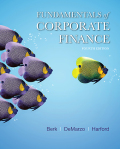
Concept explainers
Capital:
Capital refers to financial assets or the financial values of assets, like funds held in deposit accounts and tangible machinery and production equipment used in factories and firms. It can also be referred as the money, credit, and other types of funding that create wealth.
Cost of capital:
Cost of capital can be defined as the
To ascertain: The reason why a firm’s capital has a cost.
Explanation of Solution
Cost of capital is the cost paid to the investors for making an investment in a firm. It may be in the form of Dividend cost or Interest cost. In certain firms, there will be also some non-monetary costs such as Bonus shares and Right shares.
A firm may raise money from both equity and debt. Both the equity holders and debt holders in a firm have a definite rate if return, since they forego the opportunity to invest the money in some other investment. The activity of providing this is the cost, which a firm bears in order to obtain capital from investors. Such cost is measured by the Cost of capital or the Weighted Average Cost of Capital.
Hence, a firm’s capital has a cost in order to pay to the investors for making an investment in the firm.
Want to see more full solutions like this?
Chapter 13 Solutions
EBK FUNDAMENTALS OF CORPORATE FINANCE
- Stock rises from $80 to $100. % Increase?A) 20% B) 25% C) 15% D) 10%arrow_forwardFinance question 7. A person buys a stock for $100 and sells it for $120. What is the gain?A) $10B) $20C) $25D) $15arrow_forwardFinance question 7. A person buys a stock for $100 and sells it for $120. What is the gain?A) $10B) $20C) $25D) $15arrow_forward
- A person buys a stock for $100 and sells it for $120. What is the gain?A) $10B) $20C) $25D) $15arrow_forwardi need help!! If you invest $1,000 at 10% compound interest for 1 year, the amount is:A) $1,100B) $1,050C) $1,200D) $1,000arrow_forwardIf you invest $1,000 at 10% compound interest for 1 year, the amount is:A) $1,100B) $1,050C) $1,200D) $1,000arrow_forward
- I need help!! A loan of $5,000 at 6% interest for 2 years gives what simple interest?A) $600B) $500C) $300D) $200arrow_forwardA loan of $5,000 at 6% interest for 2 years gives what simple interest?A) $600B) $500C) $300D) $200arrow_forwardDear expert i need answer in this question!! What does ROI stand for in finance?A) Return on InvestmentB) Rate of InterestC) Revenue on IncomeD) Return on Insurancearrow_forward
 Essentials Of InvestmentsFinanceISBN:9781260013924Author:Bodie, Zvi, Kane, Alex, MARCUS, Alan J.Publisher:Mcgraw-hill Education,
Essentials Of InvestmentsFinanceISBN:9781260013924Author:Bodie, Zvi, Kane, Alex, MARCUS, Alan J.Publisher:Mcgraw-hill Education,

 Foundations Of FinanceFinanceISBN:9780134897264Author:KEOWN, Arthur J., Martin, John D., PETTY, J. WilliamPublisher:Pearson,
Foundations Of FinanceFinanceISBN:9780134897264Author:KEOWN, Arthur J., Martin, John D., PETTY, J. WilliamPublisher:Pearson, Fundamentals of Financial Management (MindTap Cou...FinanceISBN:9781337395250Author:Eugene F. Brigham, Joel F. HoustonPublisher:Cengage Learning
Fundamentals of Financial Management (MindTap Cou...FinanceISBN:9781337395250Author:Eugene F. Brigham, Joel F. HoustonPublisher:Cengage Learning Corporate Finance (The Mcgraw-hill/Irwin Series i...FinanceISBN:9780077861759Author:Stephen A. Ross Franco Modigliani Professor of Financial Economics Professor, Randolph W Westerfield Robert R. Dockson Deans Chair in Bus. Admin., Jeffrey Jaffe, Bradford D Jordan ProfessorPublisher:McGraw-Hill Education
Corporate Finance (The Mcgraw-hill/Irwin Series i...FinanceISBN:9780077861759Author:Stephen A. Ross Franco Modigliani Professor of Financial Economics Professor, Randolph W Westerfield Robert R. Dockson Deans Chair in Bus. Admin., Jeffrey Jaffe, Bradford D Jordan ProfessorPublisher:McGraw-Hill Education





